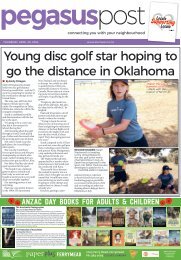The Star: August 03, 2017
You also want an ePaper? Increase the reach of your titles
YUMPU automatically turns print PDFs into web optimized ePapers that Google loves.
<strong>The</strong> <strong>Star</strong> 29<br />
Gardening<br />
Latest Christchurch news at www.star.kiwi<br />
Thursday <strong>August</strong> 3 <strong>2017</strong><br />
QUESTION<br />
I fed my camellia<br />
plants a few weeks<br />
ago with the right<br />
food. I have three side<br />
by side. One has<br />
dropped all the leaves<br />
and budding up again.<br />
What would have<br />
caused that?<br />
Today’s winning<br />
question came<br />
from Mary Sefton.<br />
ANSWER<br />
GARDENING<br />
ADVICE with<br />
Camellias, as with almost all plants, should only be fertilised during the growing season<br />
which is roughly from late October until late April. When fertiliser is applied without any<br />
uptake of nutrients by the plant, it is possible that excess soluble salts have built up in<br />
the rootzone. In many instances, this can lead to leaf fall and sometimes death of a plant. You are lucky that<br />
the plant is budding up again. Possibly in your case, heavy winter rains may well have diluted the fertiliser and<br />
therefore the possibility of a fatal outcome.<br />
What better way to celebrate Christmas than with a homemade<br />
pavlova covered in strawberries you’ve grown yourself. <strong>Star</strong>t planting<br />
now and they’ll be ready to munch on in no time! With a Daltons<br />
Premium Strawberry Pack, your strawberries will be the best in town.<br />
We have a Daltons Premium Strawberry Pack<br />
to give away, full of everything you need to<br />
grow juicy red strawberries.<br />
Valued at over $70, it contains:<br />
• 2 x Daltons Garden Time Strawberry Mix<br />
• Daltons Strawberry Fertiliser<br />
• Daltons Organic Bio-Fungicide Powder<br />
• PLUS a pair of comfortable,<br />
versatile Red Back gardening<br />
gloves from Omni Products<br />
(www.omniproducts.co.nz)<br />
BE IN<br />
TO WIN!<br />
$70<br />
PRIZE<br />
PACK!<br />
Adding compost around the base of the plant will be benefi cial for the camellia’s<br />
spring growth. Make sure to also apply light side dressings of Daltons Premium<br />
Acid Fertiliser in spring, until the tree has shown that it has fully recovered.<br />
Products to try: Daltons Compost and Daltons Mulch & Grow.<br />
For more gardening advice, read our How to Grow Guides at<br />
www.daltons.co.nz/how-to-guides<br />
Send us your<br />
gardening<br />
question<br />
to be in to win!<br />
Email your question<br />
and glove size to:<br />
chchstar@daltons.co.nz<br />
Entries must be received<br />
by 11th Aug <strong>2017</strong><br />
z<br />
Plant colourful kowhai in your native garden<br />
Veronica Armstrong says<br />
the colours of some<br />
of our favourite native<br />
plants are a welcome<br />
signal of the new season<br />
THE HERALD of spring in<br />
the native garden has to be<br />
the sunshine yellow kowhai<br />
(Sophora species) – even its<br />
name means yellow.<br />
Its lovely flowers have led to<br />
kowhai being considered our<br />
national flower.<br />
Admittedly, this tree or large<br />
shrub can look quite drab<br />
for most of the year, but at<br />
springtime it comes into its own<br />
by bursting into beautiful yellow<br />
flowers.<br />
I have a smaller-growing<br />
cultivar, Sophora molloyi<br />
‘Dragon’s Gold’, which is more<br />
shrub-like in size and this<br />
flowers in late winter. This year<br />
it started flowering as early as<br />
June, perhaps due to our milder<br />
autumn.<br />
Kowhai are significant to<br />
Maori and the flowering on<br />
bare branches, before the leaves<br />
appear, was a signal that winter<br />
was over, frosts were past and it<br />
was time to plant the kumara.<br />
<strong>The</strong> nectar in the tubular<br />
yellow flowers is keenly awaited<br />
by our nectar-loving birds, the<br />
tui, bellbird, kaka and kereru<br />
who flock to the trees. I have<br />
counted as many as 20 tui in a<br />
neighbouring large old kowhai in<br />
spring.<br />
After flowering the seeds form<br />
in pods that hang down from the<br />
branches.<br />
<strong>The</strong> seeds usually need<br />
scarification (abrasive rubbing to<br />
allow water into the seeds) before<br />
germinating. This can happen<br />
when seeds pass through the gut<br />
of birds, too.<br />
<strong>The</strong> trees do self-seed and I<br />
often find seedlings popping up<br />
in the garden that can be potted<br />
up.<br />
Unusually for New Zealand<br />
trees, some species of kowhai are<br />
deciduous and lose their tiny,<br />
green leaves in winter. Other<br />
species have a juvenile stage of<br />
densely tangled branches before<br />
reaching tree size and starting to<br />
flower.<br />
<strong>The</strong> only downside to growing<br />
kowhai is to take care as all parts<br />
of the tree are poisonous, as are<br />
so many of our garden plants.<br />
<strong>The</strong> magazine for<br />
gardeners who<br />
like To geT <strong>The</strong>ir<br />
hands dirTy<br />
www.gardener.kiwi<br />
100%<br />
Bring this ad in to claim<br />
your free pack of Native<br />
Plant Fertiliser Tablets<br />
before 15 <strong>August</strong> <strong>2017</strong>.<br />
Christchurch Garden Centre<br />
Open daily 9:00 am – 4:30 pm<br />
478 Marshland Road, Marshland<br />
Telephone : <strong>03</strong> 385 9008


















